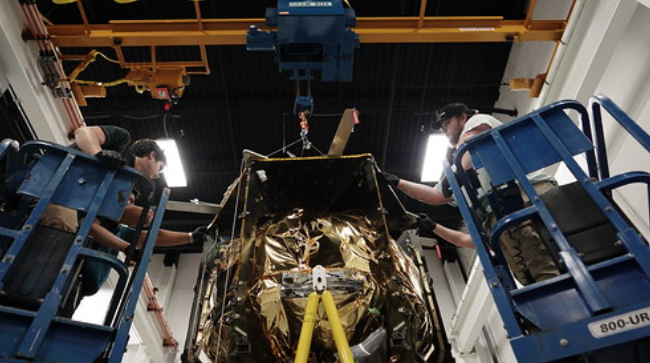
IM-1 Nova C assembly.
HOUSTON—Intuitive Machines (IM), one of 14 NASA Commercial Lunar Payload Services (CLPS) providers, is aiming for a Nov. 15 launch of the agency initiative’s first Artemis-era Moon landing.
The IM-O1 mission’s uncrewed Nova-C lunar lander is to touch down near the Malapert A crater, a relatively flat region within the heavily cratered southern highlands of the Moon’s near-side south pole.
Nov. 15 is the opening of a six-day period for a SpaceX Falcon 9 launch from NASA’s Kennedy Space Center (KSC), Houston-based IM announced during a 2023 second-quarter financial report on Aug. 14. The company was awarded a $77 million NASA contract in May 2019 to land at the Moon’s Oceanus Procellarum, or Ocean of Storms, on the west border of the lunar near side.
Initially intended to unfold by July 2021, NASA moved the OM-1 landing site in May 2023 to the lunar south pole, near the Malapert A crater. The switch is intended to provide new insight into the region under assessment for Artemis III, the first post-Apollo era Moon landing mission with astronauts planned for no earlier than late 2025.
The OM-1 manifest includes five NASA and six commercial payloads. NASA’s are focused on demonstrating communication, navigation and precision landing technologies as well as gathering scientific data on rocket plume, lunar surface interactions, and the space weather environment at the unexplored lunar region that NASA envisions as the site for an internationally and commercially partnered base camp.
“During the second quarter, we were laser-focused on the final assembly process in preparing IM-1 for launch. Our lunar lander is complete and will be prepared for delivery (to KSC) in September,” Steve Altemus, IM’s CEO and co-founder, said in a statement.
The OM-1 NASA payloads include:
** Radio Observations of the Lunarsurface Photoelectron Sheath (Rolses) for a low frequency radio assessment of lunar surface photoelectron sheath density and height, acquisition of solar and planetary radio sources, and an assessment of near-surface charged dust.
The data is considered of value in assessing the environment that astronauts and rovers will encounter and provide a baseline for future lunar radio astronomy observations.
**Laser Retro-Reflector Array (LRA), a collection of eight retro-reflectors mounted on the lander to serve as a precision landmark for lunar orbiter guidance and navigation interactions to aid precision, autonomous landing operations.
** Navigation Doppler Radar for Precise Velocity and Range Sensing (NDL), a LIDAR sensor for precise velocity and range data gathering during the Nova C’s descent and landing.
**Stereo Cameras for Lunar Plume-Surface Studies (Scalpps), still and video imagery gathering to collect data on the lander’s descent plume interaction with the lunar surface. The data will be used in models for future lunar and Mars landers to help ensure the spacecraft’s safety and landing site assets.
**Lunar Node 1 Navigation Demonstrator (LN-1), a small S-band beacon to demonstrate autonomous spacecraft positioning in support of future lunar surface and orbital operations.
IM- manifest’s commercial payloads include a Columbia Sportsware Omni-Heat Infinity reflective technology material to assess its ability to insulate the lander from extreme thermal conditions. Other commercial payloads include the Embry-Riddle Eaglecam, which is to provide onboard imagery of the landing and test an electrostatic dust removal system, which could be of value in mitigating the dust accumulations on spacesuits and equipment experienced by the Apollo astronauts.
In 2018 and 2019, NASA announced the selection and qualification of 14 current CLPS providers as part of the Artemis initiative to establish a sustainable human presence at the Moon in preparation for human expeditions to Mars. At the time, the agency estimated the value of mission contracts issued through November 2028 at a combined maximum of $2.6 billion.





